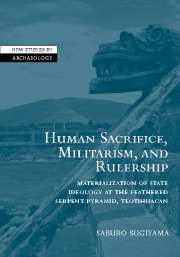 Human Sacrifice, Militarism, and Rulership
Human Sacrifice, Militarism, and Rulership Book contents
- Frontmatter
- Contents
- List of figures
- List of tables
- Acknowledgments
- 1 Introduction: cognition of state symbols and polity
- 2 Background: data and ideation
- 3 The Ciudadela and the city layout
- 4 Architecture and sculpture
- 5 Burials
- 6 Offerings
- 7 Overview: sacrificial and elite burials
- 8 Conclusion: the Feathered Serpent Pyramid as symbol of sacrifice, militarism, and rulership
- Notes
- References
- Index
1 - Introduction: cognition of state symbols and polity
Published online by Cambridge University Press: 22 September 2009
- Frontmatter
- Contents
- List of figures
- List of tables
- Acknowledgments
- 1 Introduction: cognition of state symbols and polity
- 2 Background: data and ideation
- 3 The Ciudadela and the city layout
- 4 Architecture and sculpture
- 5 Burials
- 6 Offerings
- 7 Overview: sacrificial and elite burials
- 8 Conclusion: the Feathered Serpent Pyramid as symbol of sacrifice, militarism, and rulership
- Notes
- References
- Index
Summary
Motivations and ends
When the Spanish hurried by a ruin near Otumba during their war against the Aztecs in 1521, they apparently did not recognize the huge mounds they passed as historical monuments. Even after the Conquest, they could not learn the history of the ruins from the Aztecs, who had fundamentally mythological visions of the site. The Aztecs called the place Teotihuacan (in the Nahuatl language “place where gods lived”) eight centuries after the city's fall, but its original name, the language spoken by its inhabitants, and the ethnic groups who created the city were unknown to them and are not understood today. The archaeological recovery of Teotihuacan history began only in the twentieth century.
To understand this early society, many surveys, excavations, and studies of materials have been carried out since the beginning of the twentieth century with different motivations, approaches, and techniques. Since Manuel Gamio (1922) undertook the first scientific, interdisciplinary approach in 1917–22, several explorations have successfully revealed specific cultural traits and have situated Teotihuacan prehistory within the Mesoamerican chronological framework (Table 1). The Teotihuacan Mapping Project (called hereafter TMP) directed by René Millon (R. Millon 1973; Millon et al. 1973), and the Settlement Survey Project in the Basin of Mexico directed by William Sanders (Sanders et al. 1979), largely contributed to our current view of the city (Fig. 1). Independent explorations in the city's residential compounds also provided substantial information about social life and about people of different categories and levels.
- Type
- Chapter
- Information
- Human Sacrifice, Militarism, and RulershipMaterialization of State Ideology at the Feathered Serpent Pyramid, Teotihuacan, pp. 1 - 17Publisher: Cambridge University PressPrint publication year: 2005


